 |
| AP Board Class 6 Science Chapter 11 Shadows Textbook Solutions PDF: Download Andhra Pradesh Board STD 6th Science Chapter 11 Shadows Book Answers |
Andhra Pradesh Board Class 6th Science Chapter 11 Shadows Textbooks Solutions PDF
Andhra Pradesh State Board STD 6th Science Chapter 11 Shadows Books Solutions with Answers are prepared and published by the Andhra Pradesh Board Publishers. It is an autonomous organization to advise and assist qualitative improvements in school education. If you are in search of AP Board Class 6th Science Chapter 11 Shadows Books Answers Solutions, then you are in the right place. Here is a complete hub of Andhra Pradesh State Board Class 6th Science Chapter 11 Shadows solutions that are available here for free PDF downloads to help students for their adequate preparation. You can find all the subjects of Andhra Pradesh Board STD 6th Science Chapter 11 Shadows Textbooks. These Andhra Pradesh State Board Class 6th Science Chapter 11 Shadows Textbooks Solutions English PDF will be helpful for effective education, and a maximum number of questions in exams are chosen from Andhra Pradesh Board.Andhra Pradesh State Board Class 6th Science Chapter 11 Shadows Books Solutions
| Board | AP Board |
| Materials | Textbook Solutions/Guide |
| Format | DOC/PDF |
| Class | 6th |
| Subject | Science |
| Chapters | Science Chapter 11 Shadows |
| Provider | Hsslive |
How to download Andhra Pradesh Board Class 6th Science Chapter 11 Shadows Textbook Solutions Answers PDF Online?
- Visit our website - Hsslive
- Click on the Andhra Pradesh Board Class 6th Science Chapter 11 Shadows Answers.
- Look for your Andhra Pradesh Board STD 6th Science Chapter 11 Shadows Textbooks PDF.
- Now download or read the Andhra Pradesh Board Class 6th Science Chapter 11 Shadows Textbook Solutions for PDF Free.
AP Board Class 6th Science Chapter 11 Shadows Textbooks Solutions with Answer PDF Download
Find below the list of all AP Board Class 6th Science Chapter 11 Shadows Textbook Solutions for PDF’s for you to download and prepare for the upcoming exams:Fill in the Blanks.
1. Light travels in a ——–.
Answer:
straight line.
2. A substance that gives light is known as ——–.
Answer:
light source.
3. The bouncing back of light after hitting an object is called ——–.
Answer:
reflection.
4. The color of the shadow formed by a green tree is ——–.
Answer:
Black.
Choose the correct answer.
1. Identify the transparent substance
A) Paper
B) Wood
C) Glass
D) Oil Paper
Answer:
C) Glass
2. Which of the following substance forms shadows?
A) Transparent
B) Translucent
C) Opaque
D) All the above
Answer:
C) Opaque
3. What do you need to get a shadow?
A) Light Source
B) Opaque Object
C) Screen
D) All the above
Answer:
D) All the above
Answer the Following Questions.
Question 1.
Classify the following objects into transparent, translucent, and opaque:
Cardboard, duster, polythene cover, oily paper, glass, spectacle lens, piece of chalk, ball, table, book, window glass, palm, school bag, mirror, air, water.
Which type of materials do you find more in your surroundings?
Answer:
A. Transperent Objects: glass, spectacle lens
B. Translucent Objects: polythene cover, oil paper
C. Opaque Objects: cardboard, duster, piece of chalk
I find opaque materials are more in our surroundings.
Question 2.
We can’t identify the type presence of completely transparent objects even in light. Is it correct or not? Support your answer.
Answer:
Yes, we can’t identify the presence of completely transparent objects even in Light. Because it allows light to pass through it. So we can’t find it.
Question 3.
Why can’t we see objects which are behind us?
Answer:
The reflected light behind objects of us can’t reach our eyes. So we can’t see objects which are behind us.
Question 4.
What is required to get a shadow of an opaque body?
Answer:
To get a shadow we need
- light source
- opaque body
- screen.
Question 5.
Can we use a plain mirror as a rearview mirror? If not why not?
Answer:
No, we can’t use the plain mirror as a rearview mirror. Because the plain mirror can’t cover all objects behind the vehicle. So we use the concave mirror as a rearview mirror.
Question 6.
Why do we get shadows of different shapes of the same object?
Answer:
- We get different shadows for the same object.
- because shadow shape is changed depending upon the position of the light source
- and angle position of the object.
- So we may get different shadows shapes from a same object and same shadows from different objects.
Question 7.
What are the differences between a shadow and an image?
Answer:
| IMAGE | SHADOW |
| 1. Images are colour full. | 1. Shadows does not have colour. |
| 2. Image is formed due to the reflection or refraction of light. | 2. Shadows are formed when opaque objects obstruct the path of light. |
| 3. Image gives more information such as colour, structure, etc. about the object. | 3. Shadow does not provide any details about the object but it gives an idea about the shape of the object. |
| 4. An image in a plane mirror doesn’t change in size at all; it is always of the same size as that of the object. | 4. Shadow size may be changed depend on light sources position. |
| 5. An image in a mirror can be seen without a screen, whereas it is mandatory to have a screen to form a shadow. | 5. A dark patch formed on a surface behind an opaque object placed in the path of light is called a shadow. |
Question 8.
Malati noticed changes in the lengths of her shadows during the daytime. She had some doubts about this. What could be those doubts?
Answer:
- Why shadows are always black?
- Why sometimes shadows are small and large?
- Why our shadows always follows us?
- Can we guess the time when see the shadow?
Question 9.
How can you explain the straight-line motion of light?
Answer:
- Observe the objects, the formation of shadows and the path of light as shown, in the figure.
- Similarly draw the shadows for the objects given in the fig. Extend the path of light and draw a shadow on the given screen.
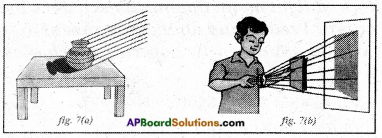
- We have drawn arrows in the above figures assuming that light travels like rays that are straight.
- We can predict the shapes of the shadows only when we consider that light travel as rays along a straight path.
- In ancient days, by observing the shapes of shadows people came to an understanding that light travels in a straight line.
Question 10.
We would not be able to see any object around us if light does not get reflected. How do you appreciate this property of objects?
Answer:
- Vision is the vital sense to organisms.
- Its possible by light reflection.
- I feel wonder by this phenomena that provide the vision.
- I also feel happy by seeing beauty nature by light.
Question 11.
Where do you find reflection of light in your daily life?
Answer:
- Due to the regular reflection of light, we look at our image in the plane mirror.
- We can turn the sunlight towards dark places by the regular reflection of light with the help of a shiny surface.
- The wing and rear-view mirrors of a car are made of a convex and a plane mirror
respectively. - A microscope uses a mirror to reflect light to the specimen under the microscope.
Activities and Projects
6th Class Science Textbook Page No. 126
Question 1.
Hold a glass slab at one end with your hand and stand in the sunlight. See the shadows of your hand and glass slab. Explain what you observed.
Answer:
- I find that glass slab does not form a shadow.
- I observed the shadow of my hand.
- It means glass slab is a transparent object and hand is opaque object.
- My conclusion is that only opaque objects form clear shadow.
- And transparent objects does not form shadows.
Question 2.
If we focus a coloured light on an opaque object, does the shadow of the object possess colour or not? Predict and do the experiment to verify your predictions. (Coloured light can be obtained by covering torch glass with a transparent coloured paper).
Answer:
- In the colour light opaque objects forms shadows.
- But they does not have any colour.
- because shadow is the place where the light is prevented.
- It does not effected by colour light.
Question 3.
Between an electric bulb and a tube light, which forms sharp shadows of objects? Do an experiment to find out and give the reasons.
Answer:
- Between electric bulb and tube light electric bulb forms clear and sharp image.
- Electric bulb is round in shape.
- It takes more voltage and forms intensity light
- That’s why electric bulb forms sharp and clear shadows.
- But at the tube light shadow it is not sharp.
- Here light source is lengthy.
- And light fell on objects from different side.
- So the shadow does not sharp.
Question 4.
A mirror is kept on the wall of your room. Your friend is sitting on a chair in that room. You are not visible to him in the mirror. How do you adjust your place so that you are visible to your friend in the mirror? Explain.
Answer:
- Its simple technique to appear to my friend in mirror.
- In mirror image formed by reflection.
- In reflection light bounce in same angle.
- That’s why I am visible to my friend when he is visible to me.
- So, I adjust my place until my friend appear to me.
- When my friend visible to me, I am also visible to my friend.
Activity – 1
1. Make your room dark by shutting the door and windows; and then put on the light. Look at any one of the objects in the room. After that, hold a plank or a writing pad in front of your face. (Page No. 117)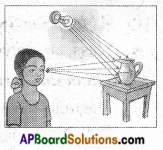
i) Is the object visible to you?
Answer:
No the object can’t visible to me.
ii) Why is it not visible though there is light?
Answer:
Light can’t reach the eyes. So it is not visible.
iii) What happens when you hold a plank between the object and you?
Answer:
Plank prevent the light. So it can’t reach the eyes.
iv) What is that something coming from the object?
Answer:
Its light that causes sight sense.
v) Where does light come from?
Answer:
A substance which gives light is known as a light source.
vi) Which objects give us light?
Answer:
Objects give us light are Sun, a glowing bulb, lighted candle etc.
vii) Can you give some more examples for source of light?
Answer:
Sun, stars, torch, candle, bulb, flame, glowing worm.
viii) When did you see shadow? Is it during day time or at night?
Answer:
I saw the shadow at day time.
ix) Are shadows formed at night?
Answer:
No, generally shadows does not form at night time. We may form shadows by using light at night time.
x) Is it possible to form shadows when there is no sunlight, bulb or any other light?
Answer:
Its not possible to form shadows without light.
xi) What do we need to form a shadow?
Answer:
We need light to get the shadow of any object.
Activity – 2
2. Try to form shadows of a book, a pen, a duster, a polythene cover, and a glass plate on the wall of your classroom with the help of a torch. (Page No. 117)
Do you find any differences in the shadow of the above objects? Do all objects form shadow?
i) Which objects form shadows?
Answer:
Book, plank, table, chair.
ii) Which objects do not form shadows?
Answer:
Glass, air, polyethene sheet.
iii) Think and write why some objects form shadows? And others do not?
Answer:
The objects which allow light does not form shadows. And which objects does don’t allow the light form the shadows. It means prevention of light forms shadows.
iv) Observe the figure. Write whether the sheet held by the boy is transparent, translucent or opaque below each of the picture?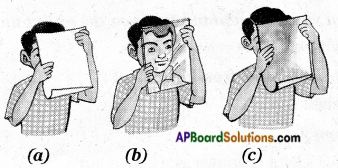
Answer:
a) Opaque sheet b) Transparent sheet c) Translucent sheet
v) Think and guess and write in table which objects in your class room form shadows, which do not form shadows and which form an unclear objects?
| Objects which form shadows. | |
| Objects which form unclear shadows. | |
| Objects which don’t form shadows. |
Answer:
| Objects which form shadows. | Benches, Chairs, Blackboard, Towel, Bicycle, Shoes |
| Objects which form unclear shadows. | Oil paper, Window, Glass pans (some), polythene |
| Objects which don’t form shadows. | Glass, Water, Petrol, Spirit, etc. |
vi) Where do you find the shadow of the leaf?
Answer:
We find the shadow of the leaf on the wall.
vii) Where do you find the shadow of the lea fin the room?
Answer:
On the ceiling.
viii) Do you find the shadow of the leaf if you remove the sheet?
Answer:
No, we do not find the shadow of the leaf.
ix) What do you understand from the above activity?
Answer:
Only light and an opaque object are not enough to form the shadow of an object. In addition to these we need a screen.
x) Can you guess the object by observing its shadow?
Guess and write the names of the objects which form the shadows?
Answer:
a) Tree
b) Ball
c) Rabbit formed as shadow with fingers
d) Musical instrument
e) Bird formed as shadow with hands
xi) What do you find?
Answer:
I found shadows which are in dark colour.
xii) Are you able to guess the object correctly in all cases?
Answer:
No, it is not possible.
xiii) What can you conclude from the above activity?
Answer:
Shadows have no colour. We can’t guess the object by observing its shadow.
xiv) Can we guess the object by observing its shadow?
Answer:
No, not possible in all cases.
Activity – 3
3. Colour of a Shadow. (Page No. 120)
Take four balls of equal size of different colours. Try to form a shadow of each ball as shown in fig. Ask your friend who is facing the screen and not able to see the balls to guess the colour of.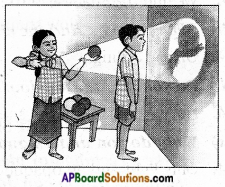
i) Is your friend able to guess the colour of the ball correctly?
Answer:
No, he not able to guess the colour.
ii) Is it possible to guess the colour of the object by observing it’s shadow? If not why?
Answer:
No, its not possible to guess the colour of the object by observing its shadow. Because any colour of object forms only dark shadows. A shadow is an area/where light is absent. Hence, the shadow is colourless irrespective of the colour of the object.
Activity – 4
Shape of Shadow. (Page No. 121)
4. Observe the shadows of a book, a pen, a duster, a ball and a round plate, one by one, in sunlight While doing this, rotate the objects to change their positions and observe the changes in shadows. Try to answer the following questions on the basis of your observations:
i) Is there any similarity between the shadows of the ball and the plate? If yes, what?
Answer:
Yes, both shadows are round in shape.
ii) What change do you observe in the shadows formed when you hold the pen horizontally and then vertically?
Answer:
The pen shadow is different when you hold the pen horizontally and then vertically. When you hold the pen vertically the shadow seems as object. When you turn the pen horizontally the shadow become round in shape.
iii) What differences do you observe ip the shadows when the duster is kept in different positions by rotating it?
Answer:
I found that duster have different shadows in different positions by rotating it. Some times the shadow seems as duster and sometimes not.
iv) Why are the shapes of the shadows of the same object different when you change the position of the object?
Answer:
A. shadow is a dark area where light from a light source is blocked by an opaque object.
B. The object may have different shapes in different angles.
C. So, the shadow shape is changed.
Activity – 5
GETTING DIFFERENT SHAPES OF SHADOWS OF A SINGLE OBJECT: (Page No. 122)
5. Take a rectangular piece of cardboard. Try to form shadows of different shapes by using it. You can do this in the sunlight or with the light from a torch. Now, answer the following questions:
i) Were you able to make a square shaped shadow?
Answer:
When I just bend the rectangular cardboard in front of light source, it forms square shaped shadow.
ii) Were you able to make a triangular shadow?
Answer:
When we gradually rotate the object towards the light source, the square shadow change into triangle.
iii) Were you able to make a circular shadow?
Answer:
No. I am not able to make a circular shadow.
iv) What are the other possible shapes?
Answer:
Rectangular, square, line, rhombus, triangle.
v) Why are we getting different shapes of shadows when the object is the same?
Answer:
Because of the straight line path followed by light rays, we can get different shaped shadows for a single object by changing its position.
Activity – 6
FUN WITH A MAGNIFYING LENS (Page No. 123)
6. Take a magnifying lens and try to form an image of a tree on a white drawing sheet.
i) What do you observe in the image formed on the sheet?
Answer:
The image on the white drawing sheet is inverted.
ii) What difference do you notice between the images formed through the pinhole camera and through the magnifying glass?
Answer:
I notice that the image formed through the magnifying lens is clearer than that formed with a pinhole camera.
iii) Can you find any other differences or similarities between shadows arid images? Write in your note book.
Answer:
Similarity:
Shadow and image are related to light.
Without light both are not visible.
Difference:
The key difference between image and shadow is that the image is the reflection of the light rays by an object, whereas the shadow is a dark shape projected onto a surface when an opaque object obstruct the light rays.
The term image generally refers to an optical representation of a real object. A shadow is black in color while an image is colorful, and represents the real colors of the object it represents.
Activity – 7
OBSERVE THE REFLECTION (Page No. 124)
7. Make your classroom dark by closing the doors and windows. Ask one of your friends to hold a mirror in his hand. Take a torch and cover its glass with a black paper leaving only slit in the middle. Now switch on the torch and adjust it so that light falls on the mirror in your friend’s hand. Ask your friend to adjust the mirror so that the patch of light falls on another friend standing in front of him at some distance.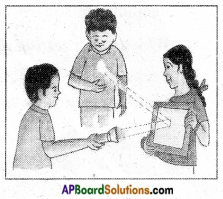
i) What do you observe from the above activity?
Answer:
When light falls on any object, it rebounds back. This is called reflection.
ii) Ask your friend A to cover the mirror with a book. Now switch on the torch and focus it on the book, Can you see the patch of light on your friend? Why?
Answer:
When mirror is covered with book I can’t found patch of light on my friend. Because the surface of book is not smooth as mirror. On smooth surfaces reflection is effective.
iii) Did the light that fell on the book not get reflected?
Answer:
The light fell on the book is reflected. But its irregular reflection. Because the book surface is not smooth as mirror.
AP Board Textbook Solutions PDF for Class 6th Science
- AP Board Class 6
- AP Board Class 6 Science
- AP Board Class 6 Science Chapter 1 The Food we Need
- AP Board Class 6 Science Chapter 2 Knowing About Plants
- AP Board Class 6 Science Chapter 3 Animals and their Food
- AP Board Class 6 Science Chapter 4 Water
- AP Board Class 6 Science Chapter 5 Materials Separating Methods
- AP Board Class 6 Science Chapter 6 Fun with Magnets
- AP Board Class 6 Science Chapter 7 Let us Measure
- AP Board Class 6 Science Chapter 8 How Fabrics are Made
- AP Board Class 6 Science Chapter 9 Organisms and Habitat
- AP Board Class 6 Science Chapter 10 Basic Electric Circuits
- AP Board Class 6 Science Chapter 11 Shadows
- AP Board Class 6 Science Chapter 12 Movement and Locomotion
- AP Board Class 6 Science 1st Lesson మనకు కావలసిన ఆహారం
- AP Board Class 6 Science 2nd Lesson మొక్కల గురించి తెలుసుకుందాం
- AP Board Class 6 Science 3rd Lesson జంతువులు – ఆహారం
- AP Board Class 6 Science 4th Lesson నీరు
- AP Board Class 6 Science 5th Lesson పదార్థాలు – వేరుచేసే పద్ధతులు
- AP Board Class 6 Science 6th Lesson అయస్కాంతంతో సరదాలు
- AP Board Class 6 Science 7th Lesson కొలుద్దాం
- AP Board Class 6 Science 8th Lesson దుస్తులు ఎలా తయారవుతాయి
- AP Board Class 6 Science 9th Lesson జీవులు – ఆవాసం
- AP Board Class 6 Science 10th Lesson విద్యుత్ వలయాలు
- AP Board Class 6 Science 11th Lesson నీడలు – ప్రతిబింబాలు
- AP Board Class 6 Science 12th Lesson కదలిక – చలనం






0 Comments:
Post a Comment